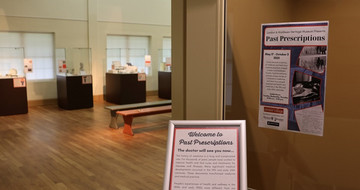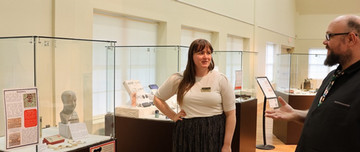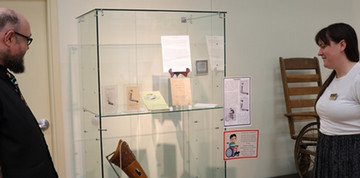Public History Students ‘Examine’ Medicine’s Past
Did you know that Alfred T. Jones, a former slave, lived in what’s now the SoHo neighbourhood of London in the 1860s and ran an apothecary shop on Ridout Street? That London was home to the second indigenous physician in Canadian history? That dental care in rural areas was often provided by barber-surgeons, who performed tooth extractions and minor surgical procedures alongside haircuts?
These are just some of the cool discoveries in a new exhibit focusing on the development of medical methods and practices and how they helped shape London and Middlesex County in the late 19th and early 20 centuries! Past Prescriptions is the result of a months-long collaborative project between the London and Middlesex Heritage Museum at Fanshawe Pioneer Village, Western’s Medical Artifact Collection, Banting House National Historic Site and students in Western’s third year public history course.
 Students David Seston, Francesco Novello and Ginger Yu in the course History 3813E: Public History, taught by Professor Mike Dove in the Department of History, provided both research support and exhibit recommendations. “The students were able to identify artifacts and share super interesting stories about how people in both rural and urban areas of this region experienced medicine within such a transformational period of medicine and healthcare,” said Dove.
Students David Seston, Francesco Novello and Ginger Yu in the course History 3813E: Public History, taught by Professor Mike Dove in the Department of History, provided both research support and exhibit recommendations. “The students were able to identify artifacts and share super interesting stories about how people in both rural and urban areas of this region experienced medicine within such a transformational period of medicine and healthcare,” said Dove.
The exhibit covers a variety of themes from the rise of medical professions including dentistry, ophthalmology and pharmaceutical medicine to the persistence of home remedies, midwifery and quackery. The project actually began in September of last year when Matthew Weickert, then Collections Coordinator at FPV, approached Professor Dove about an exhibit idea that might be attractive to public history students. “We quickly decided that this had the makings of a perfect small group project,” said Dove. “Students could provide the background research, recommend artifacts from Western’s impressive Medical Artifact Collection, and even potentially create text for the planned public exhibit.” Despite encountering a small hiccup only a few weeks in, with Weickert moving into a new position at another institution, followed by another period in which to hire his replacement, the students remained on task. “There were about four weeks in the middle of the semester where the students really had to move forward without the guidance of our partner,” added Dove, “but they persevered, stuck with it, and really helped bring this project to fruition.”
Also impressed was Stephanie Leys, the new Collections Coordinator: “The students who helped with the Past Prescriptions exhibit brought unique perspectives and skill sets that helped to shape the exhibit. Their research at Western’s Medical Artifact Collection and Western Archives and Research Collection Centre (ARCC) was particularly valuable. It is exciting to collaborate and help students bring their vision to life while gaining practical experience in the field. I hope that experiences like these can continue to inspire future museum workers to see more of the work that goes on behind the scenes.”
Some of that work involved identifying the most relevant objects from Western’s Medical Artifact Collection to borrow and display. Professor Michelle Hamilton, who manages the collection, added: “The Medical Artifact Collection is delighted to partner with Fanshawe Pioneer Village and Western's Public History undergraduate program. Past Prescriptions increases the visibility of our artifacts to the 40,000 annual visitors who come to the village. This partnership also bolsters opportunities for experiential learning by training students to research and curate museum exhibits under our mentorship.”
The students were equally appreciative. Novello saw several take-aways: “The project’s experiential learning aspect gave me the opportunity to connect with external organizations, museums, and archives. This encouraged me to stay engaged throughout the process, as it made learning about London’s medical history much more interesting. Additionally, the project provided me the experience to practice my communication and organization, which I believe are critical skills that require continuous improvement.”
Seston, the student leader on the small group project, was particularly thankful for the experience: “It was hands-on, challenging, and incredibly meaningful. Practical field experience like this is rare in undergraduate programs, and the fact that we got to work with real archives, real artifacts, and a real community partner was something I won’t forget…I got to lead a team of researchers in a real-world setting, where the stakes were more than just grades. We faced challenges, made decisions, and produced something that had a visible outcome—we can actually see our work reflected in the current display at FPV. With support from our instructor, Dr. Mike Dove, I also learned how to present complex historical information to public audiences in a clear and engaging way.”
For Seston, he’s excited to carry the experience and these skills into his graduate work, as he begins his Master’s degree with the Department of History in the fall: “This project taught me how to take academic research and shape it into something that speaks to a wider audience—something that connects. And that’s exactly the kind of historian I want to be.”
The exhibit, housed in the Trillium Gallery in The Spriet Family Visitor Centre at Fanshawe Pioneer Village, is open Tuesday to Thursday between 10am and 4pm until October 3rd, with special hours set for Canada Day!
For more about the exhibit and these partners, please check out these links:

